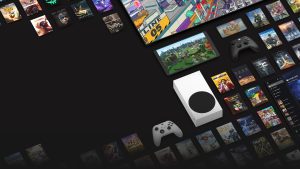
The mobile gaming market has taken off in recent years with the smartphone and tablet market. While it’s been sustainable with things like Sony’s PSP and Nintendo’s obvious domination over handhelds since the conception of their very first GameBoy. The market has really begun to change in recent years and looks like it may be moving away from our current console-based mobile gaming systems.
With powerful multi-core processors and tiny, yet potent GPU technology we’re starting to see hardware and software leap forward in ways that many people couldn’t imagine when we first got our hands on a Nokia cell phone that could play snake. Even after Apple and Android started their intense competition of one trying to beat out the other there was still a major gap between handhelds, consoles and mobile devices. Until recently most games we saw were 2D or a very simple 3D environment. Popular titles like Fruit Ninja or Angry Birds were fine if you were looking to kill some time, but unless you had a handheld like the DS or the PSP, in most cases mobile gaming was something that hardcore gamers just didn’t find as satisfying. With the leaps in technology that companies like Nvidia and Qualcomm are making recently they’ve really become the ones to watch out for .
As it stands, Nvidia’s Shield hardware has just been released. What looks basically like a modern console controller (not unlike the Xbox 360’s controller) with a screen sticking out of it, is actually a small and powerful hand held device that runs Android. It can play all your standard Android titles found in the Google Play online store. More than that though this device also has the ability pair with Nvidia’s latest video cards and wireless stream a few choice games from your desktop computer to the shield. Unfortunately the uptake for this kind of hardware is a bit slow. There aren’t that many games out that are compatible with it, but it’s a great idea and with Nvidia pushing it as hard as they are we can expect to see ever more from it in the future.
Nvidia definitely hasn’t stopped there though. To compliment their new desktop-based, Android handheld they are also working on some incredibly impressive next generation GPU asnd processing technology. This here is Ira, a detailed model of the human face. He is brought to us by Nvidia’s project Logan. The impressive thing about this is that it’s running off of the first, mobile Kepler GPU core. As good as it looks, this isn’t even as advanced as it can get! The card can actually look better when running on the desktop. What is the same in this case is things like Anti-aliasing, lighting, bloom and many other features. In fact, the mobile version of Kepler does most of what is currently being done with desktops. Ira is one of the most impressive facial renders that have ever been made and all of that is made even more amazing by the fact that it’s running on Nvidia’s next generation mobile GPU.
Ira’s facial features, skin texture and even the, moist, soft reflection of light off Ira’s eyes really helps to sell the player on realism. While this is quite obviously still a digitally rendered face, it’s an absolutely stunning breakthrough to realize this is no longer really the future of gaming. Project Logan definitely doesn’t stop here though. It’s certainly not a one-trick pony. Nvidia also has OpenGL 4.3-Tessellation in Project Logan. Now, I won’t get into the specifics of tessellation, plenty of gamers already know what it is and there are way better and in-depth explanations out on the web than I could possible give in this article.
In short though, it’s a way to render much more detail in games. It is also much more efficient in the way it works compared other forms of rendering. This kind of technology is a huge leap forward in mobile device gaming. With the Tegra 4 already available and looking wonderful for mobile gamers now we can look forward to Project Logan ,which most likely will be released as the Tegra 5. Nvidia is making some good time with it too, with rumors about it being released in the second or third quarter of 2014. All they have to do is continue releasing these captivating tech demos in the meantime to satisfy our curiosity. Nvidia looks like they’ve got a bright future in mobile gaming ahead of them as they continue to push forward in the mobile market.
While Nvidia’s up and coming processor is nice, Qualcomm’s SnapDragon series of processors is also looking quite pretty these days too. Their new SnapDragon 800 is a 2.2 GHz Quad-Core CPU that has all the great rendering capabilities that the previous 600 series has, but is now much better at rendering much larger environments with many more characters on-screen and is boasting a 75 percent jump in efficiency and power. With real-time reflection and an incredibly detailed environments SnapDragon 800 has a lot going for it in the very near future.
Their processor and GPU combinations allow them to have much more efficient load balancing. Saving on power and only using GPU processing when necessary. On the flip side if one processor is being a bit overloaded the other can help with all the processing that needs to be done. Qualcomm is certainly willing to take Nvidia head on in the mobile processor and GPU market with their new hardware and in some respects it definitely has a definitive edge over the competition.
There is virtually no wait left at this point for the SnapDragon 800 compared to Nvidia’s Project Logan. This is great news for people who are looking into new phones and mobile devices come the Holiday season. The Sony Xperia Z Ultra is on it’s way out and will have the new SnapDragon in it. The device itself is a pretty big smartphone but looks wonderful. While it’s not out yet we can expect this device to be available in mid-September, but that’s a pretty short wait. Qualcomm is also hedging their bets and putting this high-end mobile processor in other devices like tablets and smart televisions and is going to be in a whole new set of products. The chip manufacturer has actually started to pick up their marketing scheme too. They want some more brand recognition in the market and have started putting out some rather animated and quirky commercials instead of just relying on word of mouth, tech articles and the advertisements for the devices that actually use their hardware.
With all the interest they’ve taken in the high-end processor market Qualcomm has had to step up their game. Competing against companies like Nvidia and Samsung who are well-known in the market to your average consumer is certainly bringing out their more colorful and competitive side, for both the good and bad it seems. If you want to see something that is painfully entertaining then I would have to recommend watching the Qualcomm 2013 keynote speech. While it’s pretty hilarious in a Ben Stiller, “Meet the Parents,” socially awkward and painful sort of way, the technology speaks for itself.
Both Nvidia and Qulcomm are interested in keeping the competition fierce with the next hardware for both companies becoming available in either the immediate or very near future. Whatever technology you choose though there will be something to like about it. Both of these companies are making great strides in advancing the the mobile gaming market.
While both of these companies are making big waves, they have taken a decidedly different approach to it. Nvidia, being the high-end gaming GPU company that they are, is focusing more on the gaming market, while Qualcomm is working on their branding as well as getting their advanced processor lines in as many “smart” devices as they possibly can. In a lot of ways, they are starting to bring some serious competition to the desktop gaming and console markets. It will be exciting to watch as they close the gap even more in the coming year. While there are other contenders like Apple, Samsung and also Intel, Qualcomm and Nvidia are really working to push things forward. Both of these companies seem to be exceedingly well at it too.
I doubt we can expect anything from Qualcomm like Nvidia’s Project shield, however their approach to get themselves into as many tablets and Smartphones like the Sony Branded Xperia devices that focus on not only gaming but multimedia entertainment really makes it a contender because the processors are so well rounded.
As the hardware get’s smaller and more efficient the graphics are only going to be getting better. It will be interesting to see what this does to the handheld gaming market, since the PS Vita and the Nintendo 3DS are certainly going to have some real stiff competition coming up for them. Both of these handhelds are coming face-to-face with hardware that runs cross platform games. It will be tough to compete and in the coming generation the place to look for big mobile advancements may not be from the console developers, but smartphone and tablet companies like Samsung, HTC and maybe even Apple. We are going to be seeing mobile graphics that you wouldn’t believe if you didn’t see it with your own eyes.














